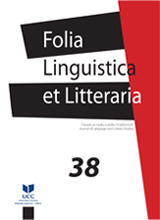«Монастырь в миру» как образ всеобщего объединения в романе Братья Карамазовы
THE LAY MONASTERY AS AN IMAGE OF UNIVERSAL UNIFICATION IN THE NOVEL THE BROTHERS KARAMAZOV
Author(s): Lazar MilentijevićSubject(s): Christian Theology and Religion, Russian Literature, Eastern Orthodoxy
Published by: Filološki fakultet, Nikšić
Keywords: lay monastery; F. M. Dostoevsky; The Brothers Karamazov; Zosima; Alyosha Karamazov; hermitry; the Church
Summary/Abstract: The article deals with the theme of a "lay monastery" (“монастырь в миру“), which became one of the important milestones of spiritual life and the life of the Сhurch in the late 19th and 20th centuries and which was reflected in the later works of Dostoevsky. According to Russian thinkers, there was an obvious need to overcome the spiritual isolation of the Church, which should show a desire to merge with the world and manifest heartfelt and vital work on this path. However, the new form and way of salvation are seen as an impulse of humanity to overcome the gap and strengthen connections with the Church. Dostoevsky thought that in the fluid and already different spiritual and historical reality, it was of the utmost importance to find or create new ways of salvation and unification. The Brothers Karamazov tells of the increasing social influence of hermits’ (подвижник). Dostoevsky suggested that their influence was utilitarian in nature and could be associated with the upper limit of Russian medieval culture in the 17th century, when the cult of saints was significantly strengthened as they were revered primarily as real helpers in secular affairs. Sanctity in Russia was often achieved by following the paths of martyrdom, passion-bearing, asceticism in its extreme forms, hermitry, mysticism and foolishness (юродство) rather than through constant, consistent, and purposeful self-discipline and abstention. However, the unifying factor is "Labor with Christ", where both joy about the world and spiritual ennobling are revealed, as Dostoevsky illustrates a path on which there is the possibility of expedient union between the laity and the Church. In the last chapter, in which Alyosha gathers the children and makes a speech, the mission of the "lay monastery" is carried out, because he manages to unite people in the name of Ilyushechka and his expected resurrection, thus, in the name of Christ. Each thing, having an absolute meaning, exists not only in a passive correlation to the other, but also takes action, fills it up and is being filled up. Only in a universal synthesis of this type, does the true miracle of universal interconnection live. Here, we are witnessing the mysterious communion of the boys and their entry into the mystical Church. One can use Lurie's successful comparison of two ways of life, secular and monastic, with Law and Grace (159). The lay monastery corresponds to the meeting of the Old Testament law and evangelical freedom, as two Christian paths that should exist in constant conjunction. Dostoevsky's thesis once again confirms the idea of Solovyov: "The Church is there where the people are, united by mutual brotherly love and free unanimity, who become a receptacle of God's grace, which is the true essence and vital principle of the Church, that forms one spiritual organism" (1914, 4: 658).
Journal: Folia Linguistica et Litteraria
- Issue Year: 2021
- Issue No: 38
- Page Range: 81-102
- Page Count: 22
- Language: Serbian

